From Gigazine, June 21, 2017. Published just before the arrival of Chapter 2, this interview with Director Nobuyoshi Habara dug deep into his history as a young fan and shed light on many aspects of 2202 production that were not previously covered.
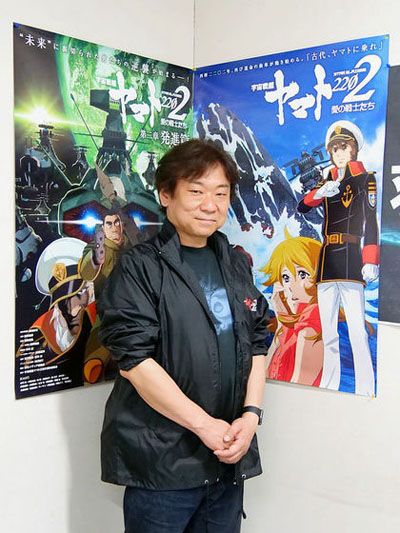
See the original post here
Interview with Director Nobuyoshi Habara, who packs the feeling of thorough Yamato love into
Yamato 2202, Soldiers of Love
Yamato 2202 Chapter 2 premieres in theaters on Saturday, June 24. This seven-chapter work takes its subtitle from Farewell to Yamato, Soldiers of Love and inherits the “2” from the TV series Yamato 2, which means its content is a remake of two works. Nobuyoshi Habara, who serves as the director, was dead-center in the generation that watched the first episode of the TV anime Space Battleship Yamato. We heard various stories about how this director makes this new work.
Gigazine (hereafter, “G”): In various interviews, you’ve talked about encountering Space Battleship Yamato in fifth grade, and you were already thinking of becoming an animator. What was the work that pulled you into the anime path?
Habara: I started having an interest in animation with Mazinger Z. The visuals of Mazinger Z changed every week, didn’t they? So I got to thinking, “why is that?” When I noticed that the director credit changed whenever the visuals changed, I thought, “there is such a job.” That was it.
G: In the fan blog Habara Research Blog, an interview was published from 2010 in which you said that Heroine was an influence on you as a director, and that Yugo Serikawa’s directing was particularly good. Mazinger Z was two years earlier than Yamato, so you must have seen it as a third grader. I was surprised to learn that you noticed the name of the director and animators. Did you check the credit roll every time?
Habara: Yes, I did. At first, I thought that those who were credited for music also did the songs. Each time Serikawa’s name appeared the song was the same, since he used the songs of the old Toei Theater version! That was a feature, so I remember thinking, “This director is amazing!”

G: Indeed, you came from such a place. In your interview about Space Battleship Yamato in the 2202 Newspaper, you talked about the flashback scene of the old battleship in Episode 2. “It was drawn by animator Kazuhide Tomonaga, and there was a lot of movement in the visuals.” If that was the case, were you drawn into Yamato by Episode 1, or by this scene in Episode 2?
Habara: When I saw the first episode of Yamato, and it started with the red Earth, the impact was huge. “What is this?” But I didn’t know exactly what channel it was on, so I think I saw it by chance. Anyway, I remember being surprised. At that time, I was more surprised by the story and how it was shown rather than the drawing itself. There was nothing else like it, and it felt very real at that time. So I was shocked to see Episode 2 and I thought, “ah, Mr. Tomonaga!”
G: At the production presentation (September 2016), you said that since the broadcast of Yamato coincided with Ape Army in your hometown of Hiroshima, there were fights over the channel, and you talked about somehow pursuading your younger brother to watch it. At that time, you got the rights to the channel and watched Yamato. After that, did it feel like a big step toward becoming an animator?

Habara at the 2202 Production Presentation, September 2016
Habara: It was definitely an influence. I also liked tokusatsu (live-action special effects), so I was attracted to Ape Army. I also loved Charlton Heston’s Planet of the Apes. I was curious, but since I liked anime the feeling was, “in the end, I have to see Yamato.” And it might have been a good thing that Heidi wasn’t on in the same time slot.
G: Its famous rival. (Laughs) It could indeed be a major point that the rival was absent. For you, it was a big thing to see Yamato. What about the people around you? Were they getting out of anime…?
Habara: That’s right. When I was in fifth grade, I was in a group that watched TV manga every day, and I went to see the Toei Manga Festival. [Anime featurettes] It was an environment where you couldn’t talk about it openly. So I went to the theater under the guise of “I’m taking my younger cousin there.” That was the feeling of it.
G: Was it a situation where almost no one else watched Yamato?
Habara: Some of my friends were watching, and a small group said “this is good.”
G: There was a gap of time between the TV series and the movie Farewell to Yamato. Harutoshi Fukui talked passionately about Farewell. For you was it an atmosphere of “let’s all go see it together”?
Habara: Just before Farewell came out it was introduced in Animage magazine, and when I was a junior high student there was the feeling that an anime boom had come. There was the compilation movie before Farewell, and the feeling was that everyone around me was watching anime.
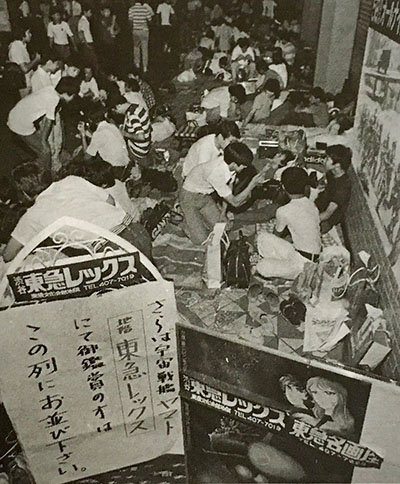
Fans waiting overnight to see Farewell, August 1978.
G: You mean the first feature film? When Farewell was in the air, it had some weight to throw around.
Habara: That’s right. It was an atmosphere where I might have cut school to go and see it. (Laughs)
G: I see. I heard that you were one of those who went on the first day and shed tears.
Habara: I went, I went. The whole theater started crying from the halfway point. It was truly amazing.
G: When you went to see other anime in the theater, that was a sight you wouldn’t see very often.
Habara: It wasn’t there. First of all, the Toei Manga Festival didn’t have such an atmosphere, and in many cases feature film anime was re-edited [from TV episodes]. I think Yamato was the first one that made me cry. When Titanic was released, everyone started to cry about halfway in. That might have been close to the atmosphere inside the theater.
G: Well, it’s easy to understand with Titanic. Farewell to Yamato had a heavy ending, and Yamato 2 started just a couple months later. Whenever I ask people about this, I always say, “did you cry?” How did you hear about Yamato 2?
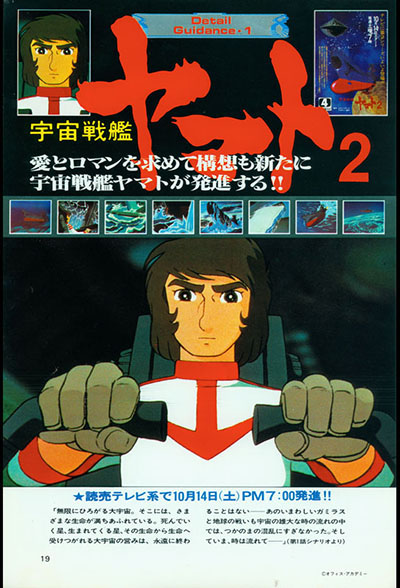
From Animage magazine, 1978
Habara: I think I read about it in Animage and said, “what’s this?” (Laughs)
Habara: I was surprised because we were told, “Goodbye to everyone who loved Yamato, it will never appear again,” and now the feeling was “Eh?” But I was more into drawing than the story, I was pleased to see that Yoshinori Kanada was involved once it started. So, conversely, I remember Yamato 2 more for the visuals. I had a lot of memories like, “this shot and that scene are cool.” At that time I was shifting toward becoming an animator, so no matter how I looked at it, the story didn’t really come into it.
G: I see. Is it a feeling like when you hear the name of a work you remember, “There was this shot”?
Habara: That’s right. When you say, “What about this episode,” or “What did you think of that one?” I remember the scenes. (Laughs)
G: Yamato 2 had basically the same story as Farewell, but the length increased from two and a half hours to 26 episodes, which is a nice amount of work for you to direct.
Habara: Yeah, right? (Laughs) Since the film stock changed from 35mm (feature) to 16mm (TV anime) the texture and color changed a bit, which was surprising. I liked the color and backgrounds in Farewell, but I was a bit disappointed when I saw Yamato 2 and got the impression that it was “a bit thin.” I didn’t know whether that was the result of it being on TV or not…
G: Even if you didn’t know the cause, you felt that the texture and color had changed. Indeed, I think you had that impression because you paid attention to the visuals the entire time. Yamato 2 came along after Farewell sparked a big sensation, so what was the situation and environment that surrounded it?
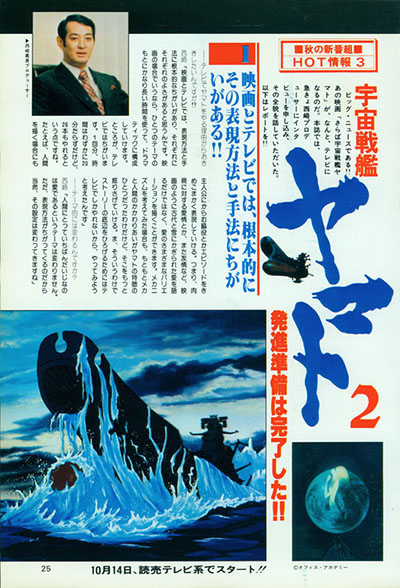
Habara: Since the anime boom was already underway for Yamato 2, everyone was watching anime.
G: Then, it was OK to watch anime even in junior high…
Habara: I think that was the atmosphere. But people around me were only talking about drawing. (Laughs) Everyone may have been adapting to me.
G: Were you excited about Yamato 2?
Habara: Yes, but we only talked about the visuals. (Laughs)
G: That’s good. It was good to be in such company…
Habara: I’m grateful.
G: In a way, Yamato 2202 is a remake of both Farewell and Yamato 2. You said that you were surprised to see that Mr. Fukui had put the subtitle Soldiers of Love in the plan book. Was the plan to remake Farewell and Yamato 2 as a sequel to 2199 from the beginning, or was there a form where it was just a continuation of 2199? And then it was decided afterward to do it as a remake?
Habara: When I was told about it, it was meant to be “a new thing that feels like a mixture of Farewell and Yamato 2.” It had already been decided that it would continue from 2199.
G: When you say “feels like a mixture,” did you have any kind of confusion like, “How can this be done?”
Habara: I was very worried about how to do the ending. But Mr. Fukui already had a plan for that. When I heard about it, I had the convincing feeling of, “that’s it!”
G: Hideki Oka, who participates as a scriptwriter with Mr. Fukui, was also a director on the Ultraman series. I heard that he is participating at your recommendation. Did you say, “if we do Yamato, we have to get Mr. Oka”?
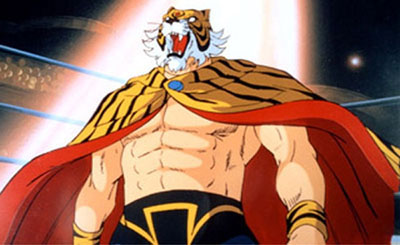
Tiger Mask
Habara: At that time I didn’t hear that Mr. Fukui was involved, so when the producer asked, “Do you know anyone who can write scripts?” I was allowed to recommend Mr. Oka. Originally, I met him when he was the assistant director on a live-action project, and I did storyboards for CG scenes. When he told me, “I watched your work on Machine Robo,” we hit it off. He and I were both into Tiger Mask, so it was like both that and Yamato got us going. (Laughs) Then I got involved in Yamato Resurrection, and Mr. Oka came to see me at a screening and said, “Resurrection was great” and that exciting feeling of, “what did you think about it?” swelled up again. He’s one of those who knows a lot about Yamato and I knew he liked it, so when I was asked if I knew anyone who could write scripts, as a director I was able to reach out to him.
G: I see. Mr. Oka focuses on tokusatsu (live-action special effects), so this may be his first anime work. It’s quite a hallmark for it to be Yamato.
Habara: Yes. Yamato has a “soul”…that’s what I think. (Laughs)
G: In your message about the series production you said, “I’ll give it my soul.” (Laughs)
Habara: I think that’s what Yamato is all about. I took the baton from 2199 director Yutaka Izubuchi, and since I was allowed to participate on the staff I got a close look at his careful calculations. He and I go back about 30 years, so I know how hard he works, and I wanted to inherit such a feeling. There are a lot of things I can’t do, so the feeling is that in places where technology and writing aren’t enough, you have no choice but to put your heart and soul into it.
G: Yamato takes a direct hit from Habara and Oka. Also, when I spoke to Mr. Fukui, he said his feelings for Farewell were strong even though he wasn’t able to see it in the theater at the time. I imagine that it was serious work when all of you finally gathered together for a meeting.
Habara: It sure was. (Laughs) Mr. Fukui is a mountain of ideas, and when we talked about the story I thought, “I can’t even come close to this.” Even at the storyboard stage I get various advice like, “I think this line should be a little longer here” and even though I’m in the director position, the feeling of everyone making this together is very strong. As the director I do a lot of interviews like this one as the representative, but the feeling really is that it’s made by a lot of people gathered together who really like it. But if it’s not interesting, I’ll take all the responsibility myself.
G: You’re on-site with Mr. Oka and Mr. Fukui, but who else on the main staff has a strong personal view on Yamato?
Habara: There are a lot of really intense people. Assistant Director Makoto Kobayashi says, “I’m not that familiar with Yamato,” but talks about it in great detail. Maybe he’s a little shy. In fact, he truly loves Yamato and keeps pushing it forward. Then there’s our young Art Director Yoshio Tanioka, who is actually from Kure where the Battleship Yamato was built.
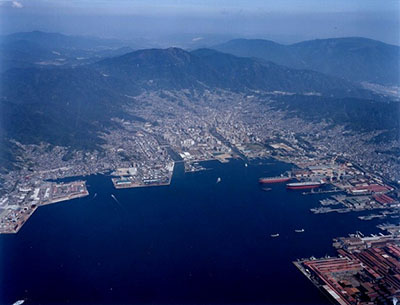
The shipbuilding port city of Kure, Japan. Birthplace of Yamato.
G: That’s a great edge to have.
Habara: Whether or not it’s related to the building of Yamato, it seems to be the system there that they love the Battleship Yamato and Space Battleship Yamato. It’s very encouraging that there are people on the staff who “are very familiar with Yamato.”
G: Speaking of generations, they’re not in the generation directly hit by Yamato, are they?
Habara: It’s natural for young people to be quite detailed. The opening of Chapter 1 was made in the form of a compilation, but it will be more of a “full version” in Chapter 2. The images depict the reconstruction of Yamato. Originally, when I thought about how to make the opening, I thought that the Yamato no one has seen yet is “Yamato under construction.” So I wanted to depict the state of passionate men making Yamato.
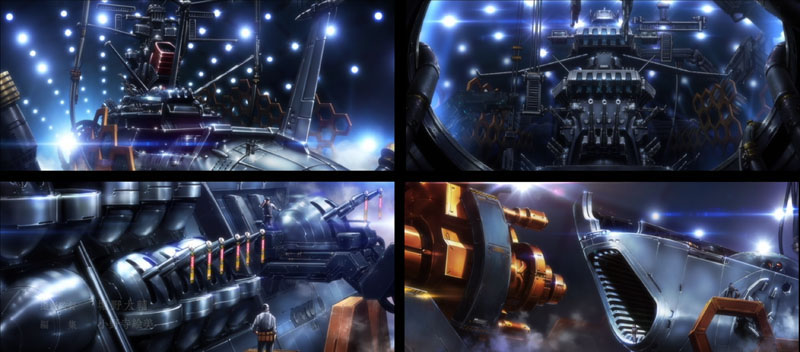
G: That’s intense.
Habara: We don’t know their names or who they are as characters, but I wanted to put in the people involved in the construction. When I consulted with Kia Asamiya during the storyboard stage, I talked about various things. “This shot could be good.” “Let’s show this.” In the end I had him create the original art. The final work of coloring and adding backgrounds took the form of harmony. [Translator’s note: this term refers to painted versions of art that would usually be rendered as cels.] Characters also appear, and when the background painters applied their work, they studied Mr. Asamiya’s customary illustration style. It was done on the basis of “Mr. Asamiya would do this kind of painting,” so we were able to do some great stuff. It’s a series of stop-motion pictures, but they’re wonderful. I think it was due to the Yamato mania of an art director like Mr. Tanioka. I want you to see it by all means.
G: Mr. Asamiya did the illustration for the set of 7 advance tickets, which shows the near miss of Andromeda and Yamato. I remember being surprised that such an image would appear before the premiere of Chapter 1.

Habara: It appeared quite early, didn’t it? I was surprised, too. (Laughs) The publicity department felt that it would be popular.
G: You, the director, were surprised, too?
Habara: No, not really, but what surprised me the most was the work of the CG team. When the scene of Yamato and Andromeda passing each other was done in storyboards, a very similar angle was used. It’s a scene that appeared in Yamato 2, and because the CG team was inspired by Mr. Asamiya’s illustration, it appears in the story at about the same angle.
G: When I saw the scene in a trailer I thought, “it’s exactly the same as the illustration.” That’s because it was meant to be.
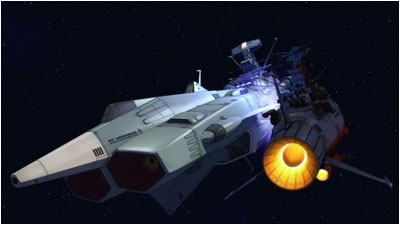
Habara: That’s right. I also spoke with the CG director and said, “I want you to show this a little more.” I think the scene was only five or six seconds long in the storyboard, but by expanding it to about double, it gave them the feeling of passing each other slowly and carefully.
G: This was an original scene in Yamato 2 that doesn’t exist in Farewell, so 2202 isn’t simply a remake of Farewell. It could be done because it is mixing the two.
Habara: We were able to reach a good place.
G: As for the flow after this passing, I felt that Mr. Fukui and Mr. Oka did their work skillfully.
Habara: That’s right. Yamanami reappears from 2199, and it was very natural to set him up in it. I think that’s what allowed us to manage the visuals.
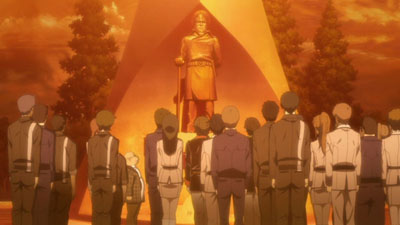
G: When you look at the beginning of Chapter 1, it’s completely new and makes you wonder if this is a remake, but then the homage scenes appear, and the scene on Hero’s Hill in particular was completely reproduced from Farewell. The relationship between Earth and Garmillas has changed, which means big changes occur on the inside, and it comes together with no sense of mismatch.
Habara: At Hero’s Hill, the scene when Nanbu shouts at Andromeda is also in Farewell. The feeling of contrasting Yamato‘s position with the reconstruction is more deeply depicted [in 2202] than in Farewell, so his shout goes from “bakayaro” in Farewell to the more intense “bakiyaro.” I thought that would express a sense of despair and anger.
G: Because this scene comes up after the fight with Gatlantis in 2202, it feels better. In Chapter 1, Andromeda strikes with the Wave-Motion Gun as soon as possible, and when Gatlantis’ giant battleship Kalaklum comes out, I was like, “what is that??” The director wants us to see a “cool fleet battle” and make us taste hope and despair. (Laughs) Was it decided from the beginning that those elements would appear in Chapter 1?
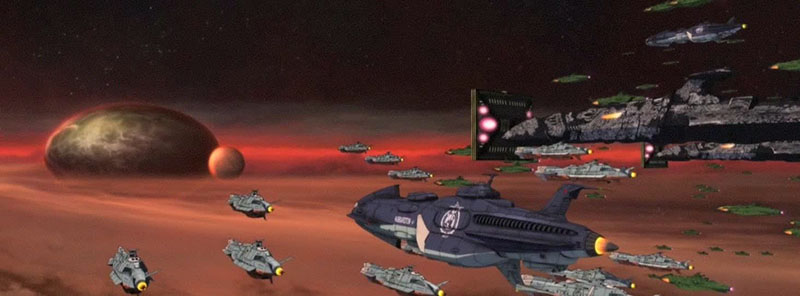
Habara: I thought it would be good to show a lot of resources. Neatly arranging fleets was done in 2199, so when I thought about what to do this time, I wanted to get as much flash and power in there as possible.
G: When the Kalaklum came out of that huge rock, even though there was nothing strange about the presence of a huge rock, I was overwhelmed and said, “did that really come out of there…?”
Habara: That was Assistant Director Makoto Kobayashi’s idea.
G: In the Garmillas fleet that fought this huge battleship, there is a ship called the “Armor Rush type Zoellegut” that holds up a shield in front of the battleship. I was surprised to see “this ship has a shield.” Was that also Mr. Kobayashi’s work?
Habara: I was surprised that veryone who saw that visual said “Eh? Shields!?” “What’s going on?” When it comes to the screen, that’s another Yamato-like part.
G: How did you come up with the image of the special forces holding up and pushing a shield?
Habara: That scene is in space, so I didn’t think it would ultimately become that bright, so when we panned over the Earth fleet I thought I would be nice to see only the Garmillas mark. Its purpose was to act as a shield, and it settled into the shape you saw after various adjustments.
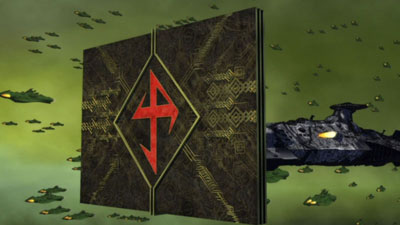
G: There are many surprises in the design, such as the Gatlantis “Needle Slave” that attacked Telezart. I got excited by it. “It shoots actual needles! They stick!”
Habara: That’s pretty horrible. (Laughs) Of course, it was another Kobayashi idea. He also took charge of the design. Its purpose was to express the coldness of Gatlantis.
G: We mentioned Andromeda a little earlier. The fact that one ship in the Andromeda class was expanded to four ships also caught the eye.
Habara: That was also Kobayashi. I think he has some great ideas.
G: Wow, Kobayashi here, too. (Laughs)
Habara: The ideas come out faster than we can think, so I just say, “Yes, It’s wonderful!” (Laughs)
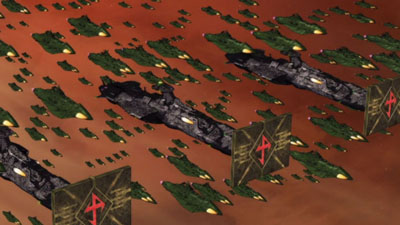
G: Sadly, Mr. Fukui has more ideas than can be included, so Mr. Kobayashi must also have more than can fit into the story.
Habara: There are so many, I’m always surprised.
G: In other interviews, you’ve said, “Mr. Fukui is an idea man, and Makoto Kobayashi is a genius.” You’ve also said Kobayashi is “amazing.”
Habara: I am amazed. We originally worked together on Resurrection and I know his technological heights, but what he does on 2202 is just a surprise.
G: Does anything else like Mr. Kobayashi’s “could there be such a thing?” ideas appear in Chapter 3?
Habara: There are already a lot! Certainly, it’s convincing that if Farewell or Yamato 2 were to be done now, they would be done like this, and it’s wonderful, isn’t it?
G: Are there things from the broadcast of Yamato 2 that became possible to depict better with current technology?
Habara: There are many parts, because it’s done in CG after all. If it was all hand-drawn…I’d probably still be making the first half of Chapter 1. (Laughs) That’s what CG is for, isn’t it?
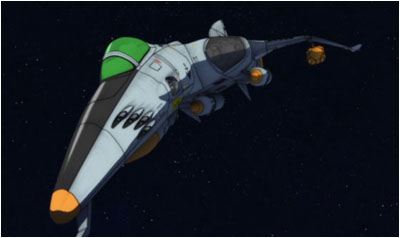
G: Chapter 1 had that massive fleet battle…
Habara: I really pressed the CG team to do the impossible, and they did it. And the Cosmo Tiger Version K will continue to evolve a little further.
G: Version K is a model with lower wings in order to make it the Cosmo Tiger drawn by Yoshinori Kanada.
Habara: That’s right. That’s part of the flash seen in Yamato, and definitely a place that benefits from good drawing. But this time, rather than running away from CG, I wanted to prove that the same flash could be done in CG, so I’ve been consulting with CG people in various ways and I still have a lot of plans.
G: In terms of that flash, I heard that the battleships were actually made in different sizes.
Habara: That’s right. The size depends entirely on the shot. Rather, the size and even the aspect ratio are different. In the scene where the Yuunagi and the giant battleship pass each other, I increased the length to more than double.
G: eh!?
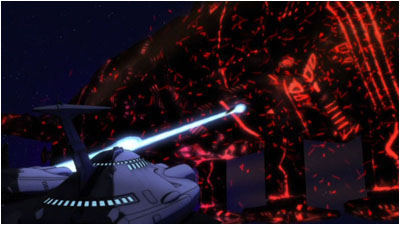
Habara: For example, when you see the plastic model of the Garmillas Zoellegut, it’s quite big. When I worked on 2199, I had the problem of, “you don’t see the real size that much when it’s on the screen.” Mr. Izubuchi glanced at it and said, “Oh? Should it look a little longer?” So when I thought about how to face the same problem in 2202, I said, “well, let’s double the length.”
G: So if I think it looks very powerful, it’s because it was stretched to double length.
Habara: There are also shots where it’s more than doubled. Andromeda is a little stretched in the scene where it passes Yuunagi, but do you notice as you’re watching it?
G: I might if it was pointed out to me, but I didn’t notice when I saw it.
Habara: Surprisingly, there’s nothing strange about it when you see the visual. There are parts where we play with the aspect ratio a little, and I try not to worry about it when I look at it.
G: Do you do a lot of deform?
Habara: I tell plenty of lies when I draw a picture. As a director, when I wonder what I want to say with a shot, I want to show something clearly rather than give accurate numbers. It’s the same as a short actor in a live-action film standing on a table that you don’t see on the screen.
G: That’s why you made the Version K apart from the normal model, isn’t it? By doing so, you reproduce the Cosmo Tiger we saw at that time so it can reappear. It’s the work of the soul, isn’t it?
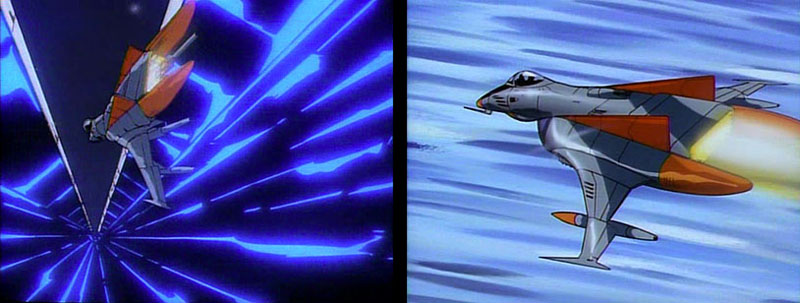
Cosmo Tiger action by Yoshinori Kanada from Be Forever Yamato, 1980.
Habara: I think that’s important. When the CG people who work on it themselves say “this is interesting,” I’m really saved. I thought about how I would pursuade them if they said, “I can’t do that.” (Laughs) They are very helpful. In current anime, there’s a part where “the size is right” is a strong theory. For example, a standing position. It’s certainly important that the standing position is correct even if the shot changes, but there are quite a few things more important than that.
G: There’s something you want to cherish more than logic.
Habara: In terms of lighting, the light may hit a subject from the front at first, but then in the next shot it could be backlit, and I don’t mind that at all. With lighting, it’s correct for the shadow to change in order to express the feelings of the character in the shot. I think anime will be over if everyone thinks, “Since the light hit from here in the last shot, it’s wrong for it to hit differently in the next one.” As with the size and aspect ratio of the battleship I mentioned before, I want to properly capture what should be expressed in a shot rather than just preserving the numbers.
G: You talked about the size and ratio of a battleship, but do you also fiddle with the directing when it comes to the character animation?
Habara: There’s plenty of that. They could be standing in a certain place in one shot and then over here in the next. For Yamato‘s bridge, I worked out the proper layout in 3D, but then I thought Yuki’s seat would be an obstruction, so I moved it back. “I want to shoot this, but you’re in the way.” (Laughs)
G: It’s like saying, “I won’t have any trouble if you move there.”

Serizawa and Todo from Episode 1. The distance between them changes for dramatic effect.
Habara: That’s right. “It’s better for you not to be on screen right now, so take a little break…” It’s important to tell a lie like that. With Chapter 1, the positions of Todo and Serizawa turned into a mess when I only followed logic, so the distance between them is different depending on the shot. But there was a purpose behind it saying, “It’s better not to have Serizawa in this shot.” Things get serious whenever Serizawa is nearby. (Laughs) I also do shots that look like they were done with a wide-angle lens.
G: Ah, even in dialogue shots. The ingenuity increases.
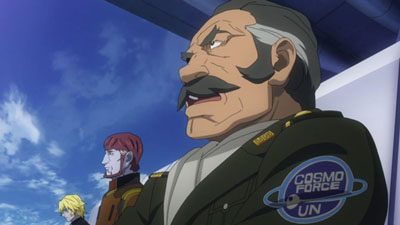
Habara: In the naval review scene, Todo, Serizawa, Burrel, and Keyman are lined up side by side. The shot is expressed with a wide-angle lens. The figures of Burrel and Keyman look somewhat far away. If you actually shot it with a wide angle lens, they would be a little closer. But because I wanted it to have a sense of distance, I told a lie to make them feel farther away.
G: The sense of distance between the hearts of Burrel and Serizawa are even shown in the picture, eh? You’re also active as an animator and have been in charge of directing mecha. Was there a time when you said, “I always wanted to draw something like this”?
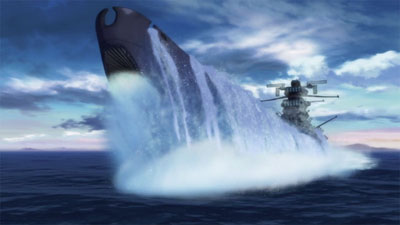
Habara: In the scene where Yamato emerges from the water, I drew some of the waves. I developed that scene while exploring the technique. At first, I had Effects Supervisor Takashi Hashimoto draw the waves that rise up behind Yamato. After that, I talked with Makoto Kobayashi and verified whether to go with CG or hand-drawing for the drifting waves on the sides, and while composing the material of waves and spray there were digital effects added by Masaya Suzuki. There were five artists altogether, and if you include video and finishes there were probably more than ten people.
G: Was there also a burning desire to do this scene?
Habara: Of course! And speaking of surfacing scenes, in the key visual for Chapter 2, Kodai and Shima are depicted and Yamato is rising from the sea. That was a time when there was nobody to draw it, and since I wanted to draw waves by myself, I got to do it. (Laughs)
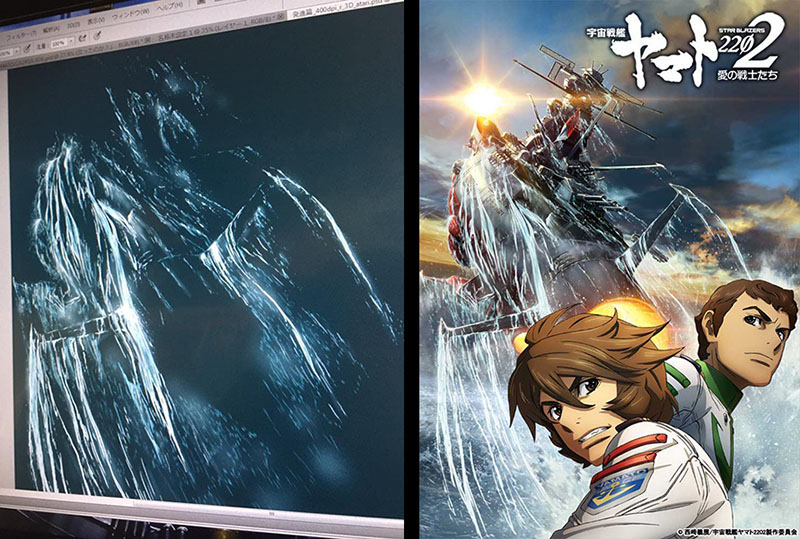
Left: Habara’s overlay art for the Chapter 2 key art image. Right: the finished piece
G: There is a burning desire for someone to draw it, after all.
Habara: Actually, I drew a similar angle once for the cover of the Yamato fan club magazine. There was a little thought of revenge there.
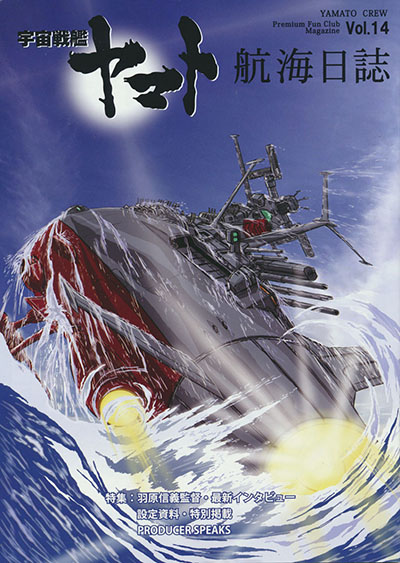
Habara’s cover art for Ship’s Log issue 14
G: Since the first key visual for Chapter 2 was the one that pushed Saito to the front, I thought it would be a tame poster, but the version with Yamato surfacing was also prepared.
Habara: That was Mr. Fukui’s idea. In terms of packaging, I think there’s a character to pick up every time, so at first Chapter 2 was only going to have the Saito image, but I decided to make it since there should always be something with Yamato coming out each time. But I can’t leave out the main staff here. I had the characters drawn by Art Director Meijyu Maeda, and we tried to use CG from the chapter as much as possible.
G: Your position is to rely on animators for the main story, but do you ever watch them and think, “I could draw that, I’m jealous”?
Habara: There is that, but I think the joy of seeing it happen is bigger.
G: Also, looking at it and saying, “That looks hard”…?
Habara: I think it’s all really hard to draw. This time the are some people in the company who are very good at freestyling it, and you can even see their work in the Chapter 2 preview. The original scenes of Santa in the wheelchair and Saito and the others helping the children are very well done. Some very fine details are drawn, like the Yamato toy held by the shaking boy. I never get tired to seeing them. When I look at things like that, I feel grateful.
G: That sounds good.
Habara: Even in Chapter 1 there was a place where we panned over the drinking figures gathered at Hero’s Hill in the evening, and you can understand from everyone’s poses and expressions that they’re thinking about various things. It makes me happy to see a mob of characters with lives to be expressed.
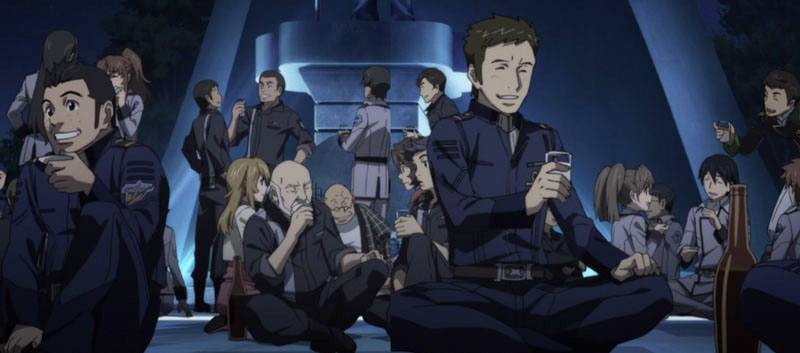
G: Many characters with individuality were born in 2199, and in that meeting scene I was interested to see “that character is there…”
Habara: The 2199 staff worked hard on those characters, so I really want to depict them carefully.
G: There is also the point that their individuality increased, and the ending of 2199 was greatly changed from the original, which collapses some of the premise of Farewell and Yamato 2. Was it hard to take that baton?
Habara: I was only involved in two episodes of 2199, but I saw how hard it was. It’s also difficult because it’s a work where you can see the effort of the staff in the film. After seeing what they did, I didn’t want to take over and later say “I should have done it that way” with regret. It may still be insufficient, but I want to do my best to the end. Of course, I think some will be dissatisfied with 2202, and I understand that feeling very well.
G: That’s because everyone has “their own Yamato,” isn’t it?
Habara: That’s it, in the end. While accepting that, I want to make 2202 in my own way.
G: 2202 is made up of seven chapters like 2199. You previously worked under Director Tetsuro Amino on Break Blade, which took up the challenge of theatrical release in six chapters. Is a series of multiple theatrical releases easier or harder than TV anime?
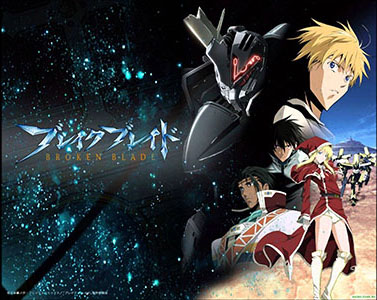
Habara: Well…when you compare the schedules, you have plenty of time for a TV series but you have very little time for a theatrical edition.
G: So you can’t really compare them?
Habara: When you think of a TV series, you can put a lot of detail into it, but that’s tough to do with a theatrical work. In the case of Break Blade, we made six hour-long pieces in one year, which is about the same as making three two-hour movies in a year.
G: When you cite those numbers, you see it differently…
Habara: It would be exaggerating to say it was like making the Star Wars trilogy in one year, but it’s still pretty tough. (Laughs) And 2202 is being made in a shorter time than 2199, so it’s hard work. It’s harder to make a story from scratch, but thanks to the characters and mecha being properly established, we can make it newer by adding more and more.
G: It was saved by the assets left behind.
Habara: But still, everyone pushes it to the very limit. Even if we ask, “is this good enough?” I think the tradition of 2199 was inherited where we say, “It’s Yamato, so let’s go a little farther.”
G: Even if an animator finishes before the deadline, I hear there are cases where they say, “I want to revise it a little more before the deadline comes.” Does Yamato always go to the last minute?
Habara: It does, it does. Even when it becomes a film, there’s always something like, “I’m sorry, let’s fix that expression a little.” It’s heartbreaking when the art isn’t ready in time for voice recording, but everyone is very skillful and they save it. Everyone at the voice recording site is really great. In Chapter 2, there’s a scene where Kato’s wife Makoto tells him, “Go there, go to Yamato.” When Rina Sato, the actor for Makoto, finished recording that line, I had to wipe away my tears when I returned to my seat. There was such feeling in it, I almost cried from just hearing the voice.

G: The voice recording had exactly the same feeling as Kato and Makoto.
Habara: From the script to the storyboard, that line changed repeatedly before the voice recording. I discussed it with Mr. Fukui, saying “let’s do it this way” and “give it this feeling,” and eventually it settled into that shape.
G: Like the scene at Hero’s Hill, which we’ve mentioned a few times, there are scenes that follow Farewell and Yamato 2, but a lot of original scenes appear, too. Makoto was a character born in 2199, so does that make it more difficult to build up her surroundings?
Habara: It’s a scene no one has ever seen. But it’s also a scene that properly grows out of the overall theme, so I gave it extra care.
G: Since Mr. Fukui said it’s about “love” from the first proposal stage, there is the relationship of Kodai and Yuki before their marriage and Kato having a family with a child, so we’re very familiar with the theme.
Habara: There are future figures to come, and these various families come out of the depth of Yamato‘s bosom.
G: The Makoto scene is included in Chapter 2. Were there other scenes that made you say, “This worked well”?
Habara: With Chapter 2, I have the feeling that it’s already completed and I have no complaints. I like all of it.
G: Not any one thing, but all of it.
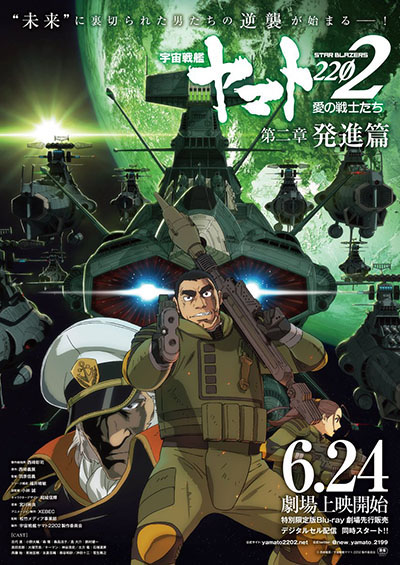
Habara: It’s the same with Chapter 1. As a director you think, “if we do the same thing next time we’ll feel differently” and “next time I want to do it a little more this way,” and it’s the same for every work. However, with respect to a finished work, all the shots are made with human hands, and because each shot has a person’s feelings in it, there’s no single shot I don’t like. Each feeling is contained in all the works I’ve done so far, so there’s something to love in all of them.
G: When you send Chapter 2 to the theater, is there a place where you say,”We struggled with this, but right or wrong we accomplished it, so please watch”?
Habara: As I said before, I did everything I could on it, including the sequence leading up to Yamato‘s launch. In the case of the launch sequence, “I have nothing more to put into it.”
G: The feeling is that it was taken from the flow of Farewell, but given an upgrade and a power-up.
Habara: Thank you very much. I love Yamato, and I think you can feel that. I also thought about doing the moment when Yamato actually emerged in cels as a return to Farewell. We couldn’t, and there was no help for it, but the feeling of Yamato mania goes on.
G: When I saw the trailer I was surprised by, “oh, there’s the near-miss scene.” Because of Kia Asamiya’s illustration I thought it would be saved as “a fun thing to see in the theater.”
Habara: It was done for the trailer as fan-service.
Bandai Visual Representative: It’s still a little bit hidden. A lot of things were sharpened.
Habara: There was a lot I wanted to do with it. Also, the new character Keyman has a good feeling in Chapter 2.
G: I thought the name Keyman was too straight and it was wordplay, but it’s really true that the character Keyman is a key man.
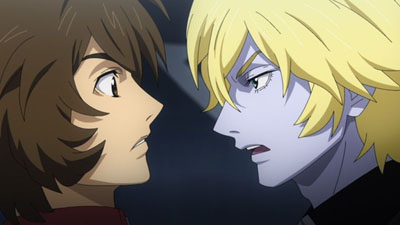
Habara: At the preliminary story meeting, everyone said, “He’s a key man after all, isn’t he?” I thought, “that’s right.” (Laughs)
Bandai Visual Representative: In the preliminary announcement for Chapter 2, Hiroshi Kimaya, the voice actor for Keyman, said two people would simultaneously say, “Prepare for impact!” Normally you would record them separately for overlap, but is it true they were recorded simultaneously?
Habara: They were. Because it’s a game of sound pressure, I thought it would be best for them to do it that way.
Bandai Visual Representative: Is there a synergistic effect from the raw acting?
Habara: I think there is. Rather than recording it the usual way, the sound director said it would be a more earnest game as a mutual moment.
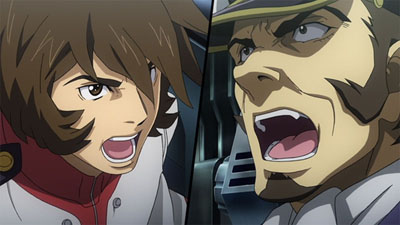
Bandai Visual Representative: In the battle between Masashi Ebara (Yamanami) and Daisuke Ono (Kodai), the first difference is their career. Ono is apt to lose since Kodai is a rookie captain, but by doing it at the same time there’s no escape for him. Mr. Kamiya said it was an impressive performance for him to try so hard as the underdog.
G: The art team was very passionate, and there was also excitement at the voice recording site.
Habara: That’s right. We record a test, a last test, and then the final performance. The test is where we start building up the performance plan, then when it comes to the last test the acting of each person is modified based on the acting of others, so it’s a “negotiation.” That’s when the feeling of a conversation begins to mesh, and there are always good people on the spot. It’s a great site.
G: I definitely want to see something in a theater that was produced from an exchange of techniques. Thanks very much for your extended time today.

I was lucky enough to have visited Kure last month while in Japan (specifically to visit the Yamato museum.) One of the most memorable events happened as we were leaving Kure that afternoon. As anyone who has taken the train or subway in Japan knows, when a train is about to arrive at a station, a little jingle is played on the platform PA system to announce it’s arrival. The music is usually unremarkable and just more background noise than anything else. But as we were on the platform at Kure and the train pulled in, what do we hear played but none other than the intro of the Yamato theme song! I thought it was very amusing (and awesome).